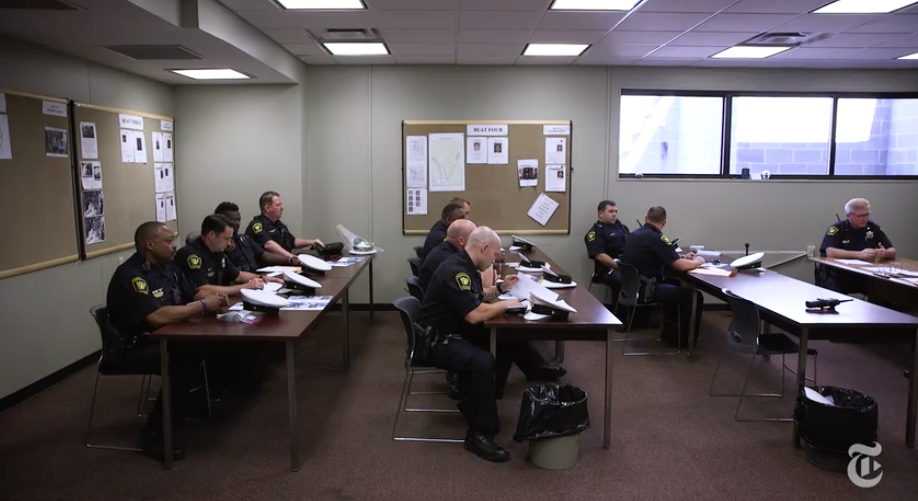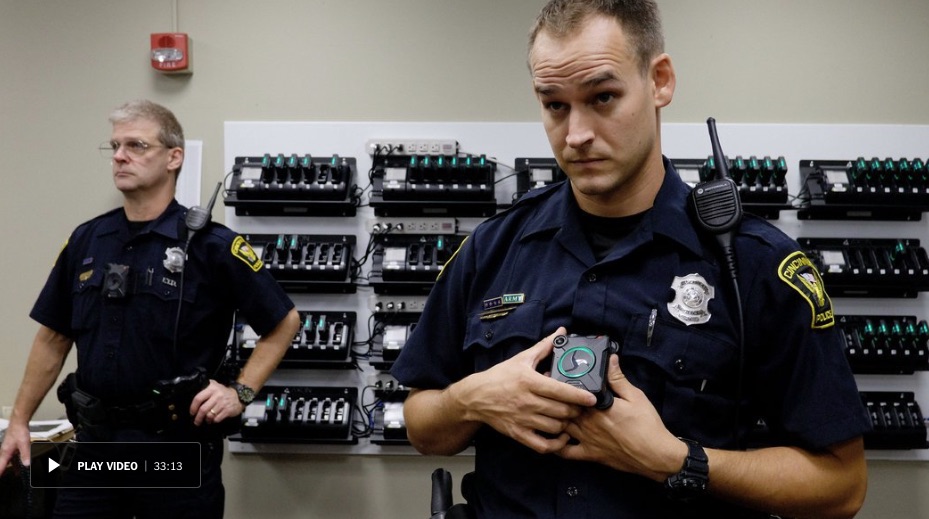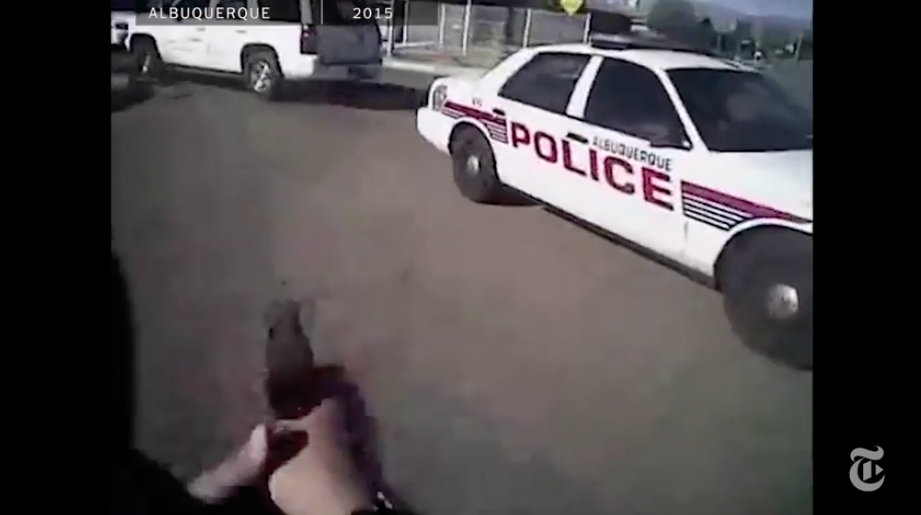How The New York Times got an inside look at police body cameras
The #TakeAKnee protest – which began as a statement against police brutality in America – has reached a fever pitch and thrown once again into relief the tensions between the public and law enforcement. Over the last few years, in an effort to address police transparency, specifically surrounding shootings, body cameras have been rolled out in countless police departments. But what have been the effects of the new technology?
Brent McDonald, a senior video journalist with The New York Times, got an insider’s look at the cameras’ use for “The Rise of Body Cameras,” a video documentary he produced with documentary filmmaker Hillary Bachelder. Published in January 2017, the documentary details the growing use of body worn cameras by police officers and the implications for police accountability.
The cameras, the filmmakers found, are not always rolling and when they are, the footage is not always released to the public, raising questions about the transparency the technology is supposed to represent. McDonald shared with Storybench his insights into working with law enforcement – in terms of access and reporting – as well as tips on establishing relationships with sources and how the “pivot to video” isn’t really a pivot at all.
You’ve done numerous pieces focusing on police issues, such as “Breaking the Code of Silence” from December 2015. What are you exploring with these stories and what are you looking to achieve?
“We started seeing more and more instances of these shooting deaths being caught on dash camera and body cam footage.”
My interest started with the protest following the shooting of Michael Brown in Missouri in August of 2014. I was there on the ground in the early days of the protest. That was the beginning, I felt, for police body cams to take off. The public was demanding more transparency, more accountability, more oversight for police officers and thinking [body cameras] would reduce the number of instances of excessive use of force and police misconduct that we’ve been seeing for some police departments. Back in Chicago, with the death of Laquan McDonald and that shooting, you started to see officers being charged. We started seeing more and more instances of these shooting deaths being caught on dash camera and body cam footage. We needed to do a deep dive and really process what we were learning, what we were seeing and whether body cams were living up to our expectation in terms of helping reduce this problem. That’s what I wanted to do with this project.
When it comes to stories related to law enforcement, what’s your process like? How long did it take you to set up, interview, edit and then release the final project?
There were really four different sub-stories to the larger project. Each one had its own timeline. The whole project took me a few months to report, produce and edit – I think it was at least three months. Then there was some pre-production to that, just finding the stories. I would say that took another few weeks at least. And the specific interviews, getting access to the Cincinnati Police Department that was one of the hardest things. I was really thankful that Cincinnati agreed to let me spend that much time with them and ride along with their officers. A lot of departments were not interested.

What led you to editing this story into different pieces?
The analytics have definitely showed us that there’s sort of a sweet spot where people will click on [the video], watch and continue to watch – under 12 minutes, I would say. I knew that what I was working on I couldn’t fit into that amount of time. I didn’t want to lose whole sections of reporting that I’d done. We ended up deciding that these should be broken up and run
“It took some reworking to re-edit so they felt like they were four standalone pieces.”
into four different videos. That took some reworking to re-edit so they felt like they were four standalone pieces. It was a few days after the initial release of that more interactive piece that we released the 33-minute single-cut documentary. I would have to go back to look at the numbers but I’m pretty sure the single length piece did just as well if not better than the smaller pieces in terms of views and completion rate. Which I thought was encouraging that people would watch a 33-minute piece on body cams.
You’re using a lot of “found footage” in the doc. What hurdles did you face when tracking down police video?
The state of Ohio has pretty open records laws in terms of getting body cam [and] dash cam footage. All I did was put in a request through the Cincinnati Police Department for a lot of that. In terms of the challenges of getting the footage, it helped to really have the specific information for an incident and then request any and all dash cam [and] body cam footage of that incident. It’s harder than saying, “Okay, I’m looking for all police shootings. Can you send me body cam footage?” It can’t be general – it has to be a very specific request.
The Times seems to be moving more and more towards video. What are your thoughts about that? Is it actually a pivot to video or have video journalists always been doing great videos?
For me, it isn’t all that recent. I’ve been doing video for The New York Times for 12 years. I’ve definitely witnessed and participated in the long evolution, the very meandering path, to where we are today, which is a much more robust and diversified video push. I think we’re much more intentional and ambitious about what we are capable of doing and what we should be doing. To me, that’s great. The sky is still the limit in terms of what we can do. We’ve identified our sweet spot as this short documentary length under 15 minutes. Maybe someday we’ll be able to go beyond that. There’s a lot of interest in video and video storytelling and reporting. It’s kind of a golden period for video journalism. I feel like the Times has helped to lead that.
“It’s kind of a golden period for video journalism. I feel like the Times has helped to lead that.”
It seems like a lot of people are nervous to appear on camera and it’s easier to get people to talk for print. What advice do you have to get people to talk to you?
I think one is just being straight, not trying to beat around the bush. Sometimes you say video and your subject has a certain association or picture that comes to mind. Maybe that would turn them off or on, but they think it’s going to be something other than what you want to be. Just being as direct as you can about what it is you would like access to to tell a certain type of story. Because access is really key. It’s not going to be a very good video story if you don’t have your subject. If your story requires spending a lot of time with the subject, they need to know that ahead of time. Maybe you spend more time with them upfront to just gain their trust, to establish a rapport, even without a camera around. I’ll definitely go to those lengths and sit down with someone and talk with them first before bringing a camera on, especially working on a story with immigration and customs enforcement, or ICE. Certain officers are really hesitant about appearing on camera. Having a relationship can be key.
What advice would you have for journalists looking to get into video storytelling?
First is identifying what is a good video story, in thinking of it not just as a supplement to your print story. That was the mindset for so long. The advice would be to identify a good video story [and] to be able to have the skills to execute on that idea, to shoot it and edit it. I don’t think you need to have a $10,000 camera or a $5,000 camera kit to do that; you can do it with your phone. [inlinetweet prefix=”” tweeter=”” suffix=”@docubrent tells @storybench”]I think all of us carry the tools in our pockets and our laptops to be good video reporters and storytellers[/inlinetweet]. I would start there.
Update: This post has been updated to clarify some responses at McDonald’s request.
- How The New York Times got an inside look at police body cameras - October 3, 2017






